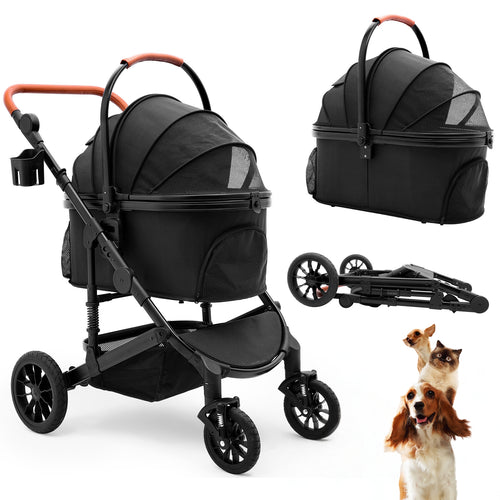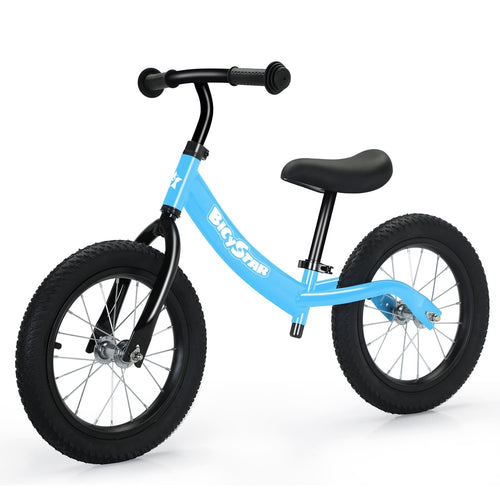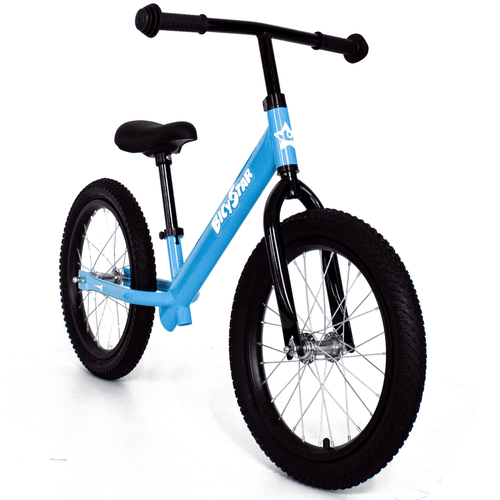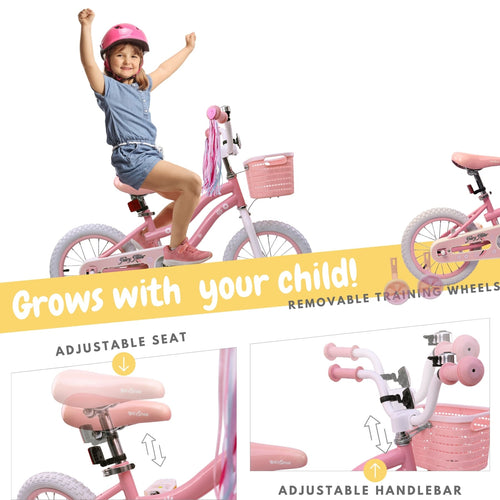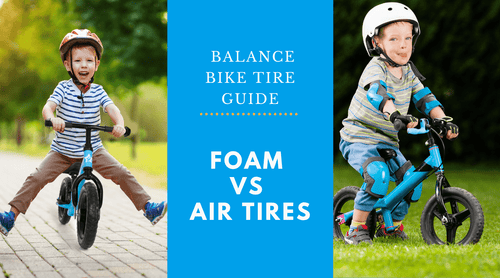Introduction
As a passionate advocate for family adventures and an expert in kids' bicycles, today I'd like to unravel the mystery around choosing the best balance bike for your child and understanding how it can ease the transition to a pedal bike. If you've seen a pint-sized two-wheeler sans pedals, better known as a push bike, buzzing around your local park, you've already met the balance bike—a tool that's revolutionizing how kids learn to ride.

Unlike conventional bikes, balance bikes focus on teaching kids as young as 18 months to balance on two wheels before propelling them with pedals. It's a foundational skill, and from my years of experience, kids who start on balance bikes transition more seamlessly to pedal bikes than those who begin with training wheels. The importance of choosing the right balance bike cannot be overstated—it's about more than just a fun ride. The proper bike impacts safety, learning ease, comfort, and, importantly, the enjoyment of those first streaks of independence for your youngster.
The balance bike market offers a myriad of choices, making it challenging to pinpoint the quality balance bike that'd turn those wobbly first attempts into confident strides and, eventually, into smooth pedaling on a mountain bike. Whether you're at the starting block of your balance bike journey or hitting the trail for an upgrade, this guide promises to steer you towards the ideal pick, ensuring your little rider's experience is nothing short of fantastic.
Stay tuned, and by the end of this post, you'll be equipped with the insights to select a balance bike that could become a cherished memory in your child's growth story. And if you find this information lightning your path, do subscribe to our newsletter for more illuminating tips on nurturing your children's strides in life. Let's dive in.
What is a Balance Bike and Why Does Your Toddler Need One?
At its core, a balance bike is a two-wheeled pedal-less bike that teaches young children how to maintain balance on two wheels. It's a simple yet profound concept: by focusing solely on balance, rather than the multitude of skills needed to operate a traditional pedal bike, kids develop a core ability that will be vital for all future bike-riding adventures.

Why learning to balance on a bike is a good and important step for your toddler? The early years of your child's life are a whirlwind of motor development. During this phase, engaging in activities that improve coordination, balance, and spatial awareness is key. A balance bike invites your toddler to learn, explore, and refine these skills through active play. The absence of pedals allows kids to concentrate on learning how to balance and steer first, which are arguably the hardest parts of learning to ride a bike. Once they've mastered this, they can move onto bikes with pedals, often skipping training wheels entirely, which fosters a greater sense of independence and achievement.
Another crucial element that often gets overlooked is the confidence boost riding a balance bike. Toddlers feel empowered when they realize they can control their movement and pace, all while having their feet close to the ground, ready to stop whenever necessary. This assurance often translates into a willingness to take on new challenges, not just in biking, but in other aspects of their young lives.
In essence, starting out on a balancing kids bike enriches a toddler's development by not only laying a solid foundation for future biking skills but also contributing to their overall growth as confident, adventurous individuals. It's these early victories on a balance bike for toddlers that set the tone for how they approach life's many adventures ahead. Now, selecting the best balance bike on the market for your little one takes a keen eye for details—something I’ll help you develop as we progress through this guide.
What Features Make the Best Balance Bike for Toddlers?
Selecting the best balance bicycle for your child involves more than picking a favorite color or pattern. Several key features contribute to the functionality, safety, and longevity of the balance bike, all of which are crucial for your toddler's riding experience.

Firstly, the seat height is a paramount feature. The best balance bikes have adjustable seats that can be changed as your child grows. A seat that is too high will be intimidating and difficult to maneuver, while one that's too low will be uncomfortable and inhibit proper leg movement. Ideally, your toddler's feet should be flat on the ground when seated, allowing them to easily push off and stop the bike as needed.
Regarding the weight of the bike, a lightweight balance bike allows for easier control and less frustration, particularly for younger toddlers. They should be able to lift and handle their bike without it overwhelming them. It ensures that your young toddler can ride a bike more willingly, without the struggle of dragging around excess weight.

Additionally, the bike tires on a balance bike can vary widely. Air tires are great for cushioning rides but require maintenance, whereas solid foam or EVA tires are puncture-proof and relatively maintenance-free, albeit with less shock absorbency. For a young toddler, having puncture-proof, maintenance-free tires means less downtime and more riding time.
Moreover, the frame's durability is another consideration. Balance bikes are often made from metal, wood, or composite materials. Metal frames are strong and can last through generations, provided they're protected from the elements to prevent rust. Wood offers a classic look and environmental friendliness but isn’t as adjustable or durable as metal. Composites are a lightweight alternative that can often withstand weathering and rough treatment.
When I advise parents on a toddler balance bike, I stress the importance of checking for CPSC certification to ensure the bike meets safety regulations. Features like rounded bolts, covered nuts and screws, and a handlebar limiter add an additional layer of safety to protect little fingers and ensure the bike’s turning radius isn't too wide, preventing falls.
One last feature often not considered but which can improve the riding experience is the incorporation of handbrakes. While not essential, as toddlers usually use their feet to stop, handbrakes can help older toddlers prepare for a pedal bike by learning how brake systems work.
Remember, the best fit balance bike for your toddler is one that they'll want to kids ride every day, fostering development, adventure, and eventually learning to balance on a pedal bike. Look beyond the colors and stickers - the construction and features of the bike can turn it from a simple toy into a developmental tool.
How to Ensure the Right Fit: Choosing a Balance Bike for a 2 Year Old vs. a 3 Year Old
Ensuring your child has the right fit in a balance bike is essential for their safety and enjoyment. The best balance bikes for toddlers offer adjustability in seat and handlebar heights to grow with your child, but the initial fit is what provides them with the comfort and confidence to ride.
For a 2 year old, look for a little balance bike with a minimum seat height that corresponds to their inseam measurement. Properly sized, a balance bike will allow them to sit with their feet flat on the ground, knees slightly bent to push off comfortably. Most 2-year-olds will have an inseam of about 12 to 15 inches, so the bike should accommodate this range at its lowest setting. A lightweight bike for kids at this age is also crucial, as their smaller bodies can't handle the demands of a heavy bike.
On the other hand, 3 year old sometimes have rapidly growing legs that challenge the boundaries of a smaller balance bike. For them, you'll want a balance bike that has a higher maximum seat height to ensure it lasts through their growth spurts. Ensure the handlebars offer a good grip for larger hands and perhaps a slightly wider frame for better balance for a 3 year old, as they can often be more aggressive in their riding.
A balance bike for ages 3 to 5 should also start introducing features that prepare them for a pedal bike, such as a freewheel hub that allows them to coast and get a sense of momentum. They are also more likely to appreciate the addition of a brake, something that may be extraneous for a 2-year-old but is a valuable learning feature for an older toddler.
Balancing the bike's features with your child’s age and physical development is key. For example, a 12 inch balance bike can be the perfect size for many 2-year-olds, while a 14 inch balance bike might be a better option for 3-year-olds who are taller or have a longer inseam.

Children grow quickly, and so their first bike needs to keep up. The best toddler balance bike will change subtly as they move from being a young toddler to a slightly older child. It’s about finding that sweet spot where the bike supports their current stage of development while also being adjustable enough to accommodate rapid growth.
Budget Balance Bikes vs. Premium Models: Which Balance Bike Option is Right for You?
When shopping for a balance bike, the price can be indicative of quality, but this is not a universal rule. A budget balance bike can be an excellent choice for parents who are cautious about investing in a high-end model, especially considering how quickly children outgrow their bikes. Budget-friendly options often have the essentials your toddler needs, including adjustable seat heights and handlebars. However, the materials may be less durable, and the bike might lack some of the more advanced features.
On the flip side, premium models can offer additional benefits such as ultralight frames, high-quality tires, and superior craftsmanship. These bikes are often designed to accommodate a wider range of ages and sizes, ensuring they'll last through several developmental stages. The investment here goes towards longevity and the peace of mind that comes from sturdy construction and proven safety features.
Regardless of whether you're looking at a budget balance option or an expensive balance bike, always ensure the basic safety standards are met. Check that the balance bike has rounded, secure fittings, a sturdy structure, and correct certifications. Balance bikes do not need to be complicated with gadgets and gizmos, but they must be safe.

One factor to consider is the resale value of a quality balance bike. Premium balance bikes maintain a higher resale value and, if well-cared-for, can be passed down to siblings or sold on. This can make up for the initial cost and offer a more sustainable approach to children's bicycles.
Also, think about how frequently the balance bike will be used. If your child is already showing a keen interest in riding and you live in an area conducive to outdoor play, investing in a best balance bike with a durable frame and weather-resistant materials may prove worthwhile. Conversely, if you're uncertain about your toddler's interest or live in a city where space and opportunities for riding are limited, a budget balance bike is a practical, low-risk option.
Ultimately, whether you choose a balance bike that's budget-friendly or a pricier option should depend on your child's needs, your budget, and the value you place on certain features. It's not necessary to dip into savings to get a quality bike; however, investing in a model that will last and provide a safe, enjoyable experience is wise.
From Balance Bike to Pedal Bike: When to Make the Transition
Mastering a balance bike is like the prelude to a child's biking symphony—it sets them up for the grand performance of riding a pedal bike. Recognizing when your child is ready for a pedal bike is a pivotal moment in their journey as a young cyclist.
So when is the right time to make the jump from balance bike to a pedal bike? Look for clear signs of readiness, such as confidence in speed and the ability to glide with feet up for significant distances. A child who can maneuver their balance bike around obstacles and stop effectively using their feet has proven a fundamental understanding and control over balance—a skill that is crucial when moving to a pedal bike.
The transition age can vary, generally ranging from as young as 3 to as old as 6 years old. It's less about their chronological age and more about skill and comfort level. Some children may show readiness earlier, propelled by daring and coordination, while others take a bit longer to develop the necessary confidence—it's important to honor their individual pace.

When they show these readiness cues, it's time to consider a first pedal bike. This bike should ideally have a similar size to their balance bike to get the best fit. Opting for a lightweight pedal bike will make it easier for your child to handle, replicating the ease they felt on their balance bike. It's also beneficial to choose a model without too many gears or complications—one that focuses on the fundamental transition to pedaling.
And don't forget the fit; just as you chose their balance bike based on inseam measurements, do the same with their pedal bike. A child should be able to touch the ground with their toes when seated to maintain confidence in their ability to stop without falling.
For a seamless switch, mimic the setting of their balance bike at first—keep the seat lower and allow them to touch the ground comfortably. As they get more accustomed to pedaling, raise the seat so they can fully extend their legs while pedaling, which offers an optimal riding position for power and endurance.
Remember, while the goal is to progress to a pedal bike, there's no rush. At this stage, fostering a love for riding and maintaining the joy found in biking should be the priority.
Shopping for a Balance Bike: Practical Tips to Find the Best Balance Bikes for Kids
Navigating the sea of balance bikes available can be daunting, so having a clear strategy for shopping for a quality balance bike or a bike with training wheels is essential. Here's how to select the ideal balance bike that satisfies your criteria and ignites your child's two-wheeled passion.
Begin by determining your priorities. Are you looking for a lightweight balance bike for easy handling or a larger balance bike that can grow with your child? Do you prioritize a balance bike with air tires for comfort or do you prefer solid foam tires for zero maintenance? Setting these benchmarks will guide your shopping process.
Getting a firsthand feel for the bikes can be invaluable. A visit to a local store can be worth its weight in gold—your child can test-ride various models, and you can get a feel for the bike's construction and weight. If a bike store visit isn’t feasible, look up product demos online, read customer reviews meticulously, and check out forums or blogs dedicated to balance biking for authentic insights.
Measuring your child’s inseam accurately is indispensable and should be the number one factor in choosing the size of the balance bike. Remember, the correct seat height of the bike should be one inch less than your child's inseam to ensure they can touch the ground flat-footed.
Be mindful of the bike’s weight. A common rule is that the bike should not weigh more than 30% of your child's weight. This is especially crucial for younger users like 2-year-olds or 3-year-olds who might find heavier bikes challenging to manage.

When online shopping for a balance bicycle, carefully check the return policies. In case the fit isn't right or the bike doesn't meet your expectations, having a hassle-free return option is a lifesaver.
Lastly, consider the longevity of the product. A durable, adjustable bike, while potentially more costly initially, may yield a lower cost per use over time. It becomes even more value-for-money if it can be handed down to siblings.
By following these tips, you'll navigate the path of buying a balance bike with as much ease and joy as your child will have riding it.
Innovative Features in Balance Biking: Balance Bikes That Convert and Grow With Your Child
The evolution of balance bikes in recent years has been substantial, with models hitting the market that offer much more than just the fundamentals of riding. One of the most significant developments is the balance bike that converts, which adapts to your child's growing skill set and stature.
These balance bikes often have extendable frames or attachable components that transform from a balance bike into a pedal bike for older kids. Investing in a convertible balance bike might mean a higher upfront cost, but it eliminates the need to shop for a new bike once your child is ready for pedals. That's not just convenient; it’s also a nod to sustainability.
Another inventive feature that I've applauded is the introduction of bikes with adjustable components. Unlike standard models, these bikes can be adjusted in multiple ways—not just the seat but also the handlebar height and sometimes even the wheelbase. Such versatility allows the bike to suit your child's needs over several years and across different developmental stages, from a baby balance bike suitable for a 1 year old to one that suits a sprightly 5 year old.
When shopping for a balance bike, consider the manner of adjustment. Quick-release clamps make it easy to adjust the bike on the fly, without tools, catering to those sudden growth spurts that kids are known for. More traditional bolts might require carrying an Allen key, but they can offer a sturdier construction.
As a side note, while not necessary for the youngest riders, integrated footrests in design can be a practical feature for older children. They mimic the position feet would be on a pedal bike and can enable a smoother transition when the time comes.
While exploring the options for your child's first bike, don’t shy away from these advanced features if they align with your child's needs and your family's lifestyle. These innovative tweaks can enrich your child's balance bike experience, offering comfort and convenience that keeps pace with their growth.
Summary: Essential Points to Remember When Buying a Balance Bike

As we reach the end of our guide, it’s clear that a balance bike is more than a toy; it's a developmental tool that sets the foundation for your child’s biking journey. Before hitting the 'buy' button or visiting the local bike shop, let’s briefly recap the most important things to remember when selecting the right balance bike:
- Adjustable Seat Height: Choose a bike with an adjustable seat to grow with your child, ensuring their feet can touch the ground for safety and comfort.
- Lightweight Frame: A heavier bike can overwhelm a small child, so opt for a lightweight option they can easily manage.
- Tire Type: Decide between air tires for a cushioned ride and puncture-proof foam tires for less maintenance.
- Safety: Look for a balance bike with rounded bolts and covered nuts to prevent injuries, and ensure the bike is CPSC certified for safety.
- Durability: Metal frames may last longer, but composite frames offer the advantage of being less prone to rust and often lighter.
- Convertible Options: Consider a balance bike that converts to a pedal bike, offering longevity and adaptability as your child’s skills progress.
- Proper Fit: The size of the bike should suit your child now—not too big or too small, with the seat height approximately an inch less than your child’s inseam.
- Price vs. Value: Budget bikes can be cost-effective, but premium models might provide more features and durability—consider what fits best for your family’s needs and values.
Let these bullet points guide you as you explore the world of balance bikes and make a choice that will bring a delighted grin to your child’s face and a sense of relief to yours, knowing you've invested in their future biking success.
If this article has steered you in the right direction and you're eager to keep up with the latest in balance bikes, family adventures, and how to nurture your little ones through the power of play, don't let the journey stop here.



